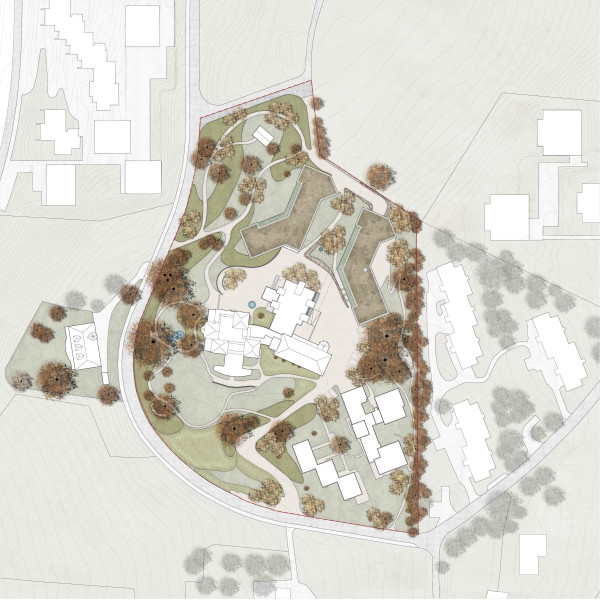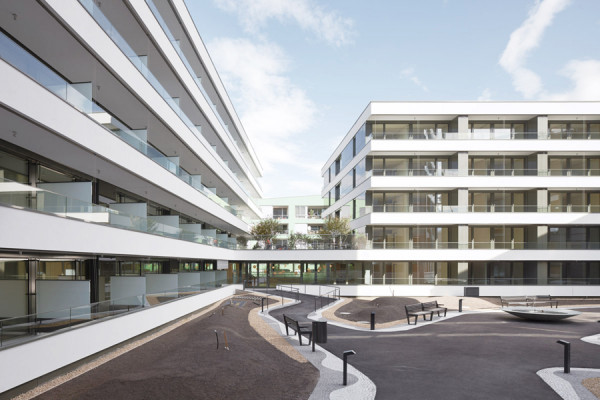Urban development
Two new station buildings will be arranged along the contour lines and will be staggered upwards behind the villa like a backdrop. The volumes are modelled over loggias and verandas. This breaks the functionally determined scale and creates a differentiated ensemble
Landscape concept
The surrounding landscape, the existing park and the settlement of the existing buildings and new buildings create the basis for the design of the surroundings. In order to clearly structure the high diversity of use and design areas, the park landscape, frame and square are typologically differentiated.
The park landscape
The existing woodland offers great quality for the future planting, it communicates with the surroundings and creates a link to the history of the place. With the exception of the necessary clearing of some trees, the stand will be maintained and developed further.
The framework
Cut hedges of copper beech now structure the open space. As a local horizon, these zone the park in different sequences. Furthermore, the red beech hedges serve as a filter between the partly sensitive ground floor uses and the park, as well as between the access roads and the clinic area. In this way, the necessary boundaries are masked and the park is visually expanded.
The squares
Embedded in this parking frame are various seats of different sizes and degrees of security, which patients can deliberately choose to visit. The access roads are also integrated into the strong vegetation concept, which meet the requirements of the traffic geometry, but follow the design rules of the park with its curved paths and thus override the infrastructural installations.
Wettbewerb
Klinik Meissenberg
 Gesundheitswesen
Zug
Gesundheitswesen
Zug Switzerland





Floor plan organisation
The new stations are arranged in 2 buildings with 2 stations each. The two buildings are similar in design, but their wording is adapted to the different programmatic and topographical conditions.
The possibility of arranging ward areas on floors other than the room floor was used in order to keep the building volumes as compact as possible and to comply with fire police regulations with only one staircase.
Accordingly, the therapy areas of the two wards in each building are grouped on one floor. Each of them is directly connected to the terrain and thus maintains an intensive relationship with the surrounding landscape. In the “Haus zum See”, the park with its mature trees and shrubs is experienced, while the terrace in front of the “Haus am Berg” is open to more intensive gardening or movement oriented use.
Above the therapy and consultation areas are the wards on two floors with their rooms facing the lake and the living and recreation areas. On the mountainside, a ridge is formed by ward and examination rooms and the office of the ward manager. Raised from the ground and staggered in height, all individual rooms enjoy an attractive view.
On the wards, patients have access to recreational areas of different dimensions and exposure. At the entrance, a central recreation room with a view over the lake offers the possibility of staying in larger groups. Other more intimate recreation rooms are located at the end of the corridors and offer a zone that mediates between the security of the room and the exposed situation of the recreation room.
In favour of the lake view of all rooms, the recreation area in the private ward has been arranged with a variety of views and a possible exit to the terrain terrace to the west.
Architect:
Studio Gugger
Landscape architect:
Vogt Landschaftsarchitekten













